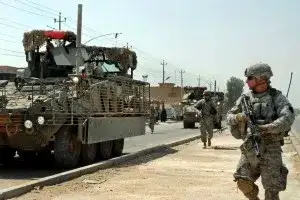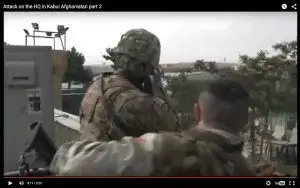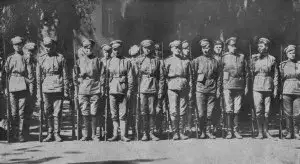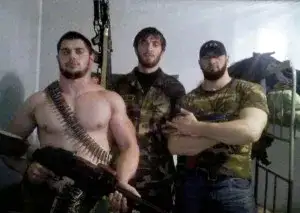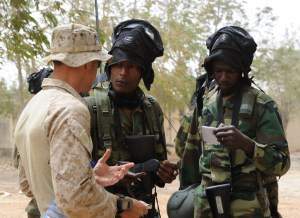About those Russians fighting in Syria
September 25, 2023 by Thomas Wictor
Last night I wrote about what I think Russia will do in the Middle East in response to an Israeli and Arab League attack on Iran. In the process of researching the post, I found a video of Russians fighting in Syria. It’s very illuminating.
Here’s the video. At 0:40 you see a Russian BTR-82A armored personnel carrier (APC), and from 2:04 to 2:15 you hear shouting in Russian.
The Russian voice is shouting, “Fire! More! Come on, more!”
Each time the voice shouts, the BTR-82A fires its cannon. Therefore someone outside the APC was using a radio to command the gunner inside the vehicle to shoot.
This is the BTR-82A.
It’s an eight-wheeled APC similar to the Stryker used by the US Army.
Although the American APC has a .50 caliber machine gun instead of a 30mm cannon, the Stryker can be fitted with additional armor. Also, a major design flaw in the Russian BTR-82A is that the men have to exit the vehicle from the side, right into enemy fire.
The Russians fighting in Syria are professionals, called “contract soldiers.” Russia has a conscript military, but after required service, people can choose to stay in. The video of the BTR-82A in action shows men of the 810th Separate Marine Brigade, part of the navy’s Black Sea Fleet.
So far I’ve not seen a single video of Russian troops that indicates that they know what they’re doing. In the Syrian footage, a commander outside the BTR-82A has to repeatedly order the gunner to fire. Compare that to this video of a US Marine Light Armored Vehicle (LAV) in Iraq. Warning on language.
Nobody has to tell the gunner when to fire his cannon. Each individual warrior knows the general plan, and then he uses his own best judgment on how to implement it. He’s been trained to function as both a team member and as one man who uses his own brain. It’s the same with these Italian paratroopers in Afghanistan.
When the Taliban launched an assault on NATO headquarters in Kabul on September 13, 2011, they were repelled by American, Canadian, French, Macedonian, and Afghan troops who couldn’t even communicate with each other. It didn’t matter. They were so well trained that they all knew what to do. The terrorists entered a skyscraper under construction and fired on the NATO troops from above, using heavy machine guns and rocket-propelled grenades.
At the end of the video, an American and a Macedonian have exchanged rifles so that the GI can use the scope to see the enemy more clearly.
After five hours, all the terrorists were killed.
In western armed forces, individual initiative is valued. Each soldier, marine, sailor, airman, or coast guardsman is trained to function as both part of a team and as a self-contained mini-army that doesn’t need to be micromanaged. It’s why good soldiering is so hard. Warriors are pulled in two different directions simultaneously; they have to balance the opposing requirements.
The Russian armed forces have never valued either individual initiative or individual lives. In World War I, the Russians relied on sheer weight of numbers. There were so many troops that they would simply steamroll the enemy. Well, it didn’t work. The Germans had a much higher level of training, so they killed Russians in massive numbers. By 1917 Russian morale was so low that the army formed female Death Battalions, women who pledged to give up their lives in useless but dramatic attacks.
The majority of these units never saw combat. Their purpose was to shame men into fighting harder. Although male Death Battalions were formed and thrown at the enemy, in the end Russian troops simply stopped obeying orders. After the Russian Revolution, the Bolsheviks signed a separate peace with the Central Powers and walked away from the war.
During World War II, the Soviets sent men into combat in groups of three: One man was given a rifle, one carried a clip of bullets, and the third man was unarmed. He was supposed to pick up the rifle and ammunition when the other two were killed. Behind them were stationed machine gunners of the NKVD, the People’s Commissariat for Internal Affairs. Their troops killed any Russian soldier who tried to retreat.
This scene is historically accurate. The men with violet cap bands and collar tabs are NKVD.
Not much has changed in Russia. Her allies Syria and Iran have internal security troops who kill retreating soldiers. Since Vladimir Putin has virtually eliminated the free press, it’s not clear how severely the Russians punish failure and “cowardice.” However, video evidence shows that Russians still don’t train their troops well.
This is a holdover from centuries of absolutism. Totalitarians almost never have exceptionally skilled armed forces. Dictators rightfully fear their own people; a military coup is always lurking in the background. Most dictatorships have masses of poorly trained regular troops and a small, elite praetorian guard that’s personally loyal to the leaders.
It’s hard to imagine what would inspire a Russian to sacrifice his life. I once had a close friend who’s a colonel in the Russian army. We got along fine until Russia invaded and annexed the Crimea in February of 2014. Although I didn’t criticize Russian actions, my former friend demanded that I take sides. He insisted that I support Russia, or he would end the friendship. Since he became completely irrational and blamed the Ukrainian crisis on Jews, Nazis, and gays, I let the relationship go.
His support of Russia is entirely tribal. When he was in the army, he couldn’t afford an apartment in Moscow, so he and his wife lived in his office.
For eight years.
They slept on military cots that they folded up in the morning, and they bathed in the sinks.
For eight years.
He was a full colonel, the head of a microbiology institute in Moscow, but the army didn’t hire janitors. After the day’s work, my friend had to sweep out the building and empty the wastebaskets.
For eight years.
I really, really liked him. He has a great sense of humor and magnificent taste in art. But when Russia began throwing around its weight, he erupted in pent-up rage that he directed at me.
“Russia is rising from its knees, Thomas!” he kept writing to me.
He finally made our friendship conditional on me supporting his ugly, facelifted, corrupt, murdering leader. I couldn’t, so my friend became my enemy. What a pitiful waste. Russia is a tragic country that can’t get its act together. The Israelis and the Arab League have warned Putin to stay out of the way, and he will. That video from Syria shows that Russian troops would be slaughtered by the IDF, the Saudi Airborne Brigade, the United Arab Emirates Presidential Guard, the Egyptian Rapid Deployment Forces—anyone who can find their own rear ends without maps.
Russians tell me that the Chechen Kadyrov Guards are considered the best fighters in Russia and have been chosen by Putin for “special missions.”
Compare them to the only known photo of the Senegalese Special Forces, trained for five years straight by the US, all of Europe, China, and the Gulf Cooperation Council. These men were sent to Saudi Arabia to fight in Yemen or Iran. Or both.
In which faces do you see professionalism and quiet confidence? To whom would you rather entrust your life?
This is my Russian former friend’s favorite song. I introduced him to it, and it became part of his family tradition. Despite everything, I wish him well.
This article viewed 578 times.

